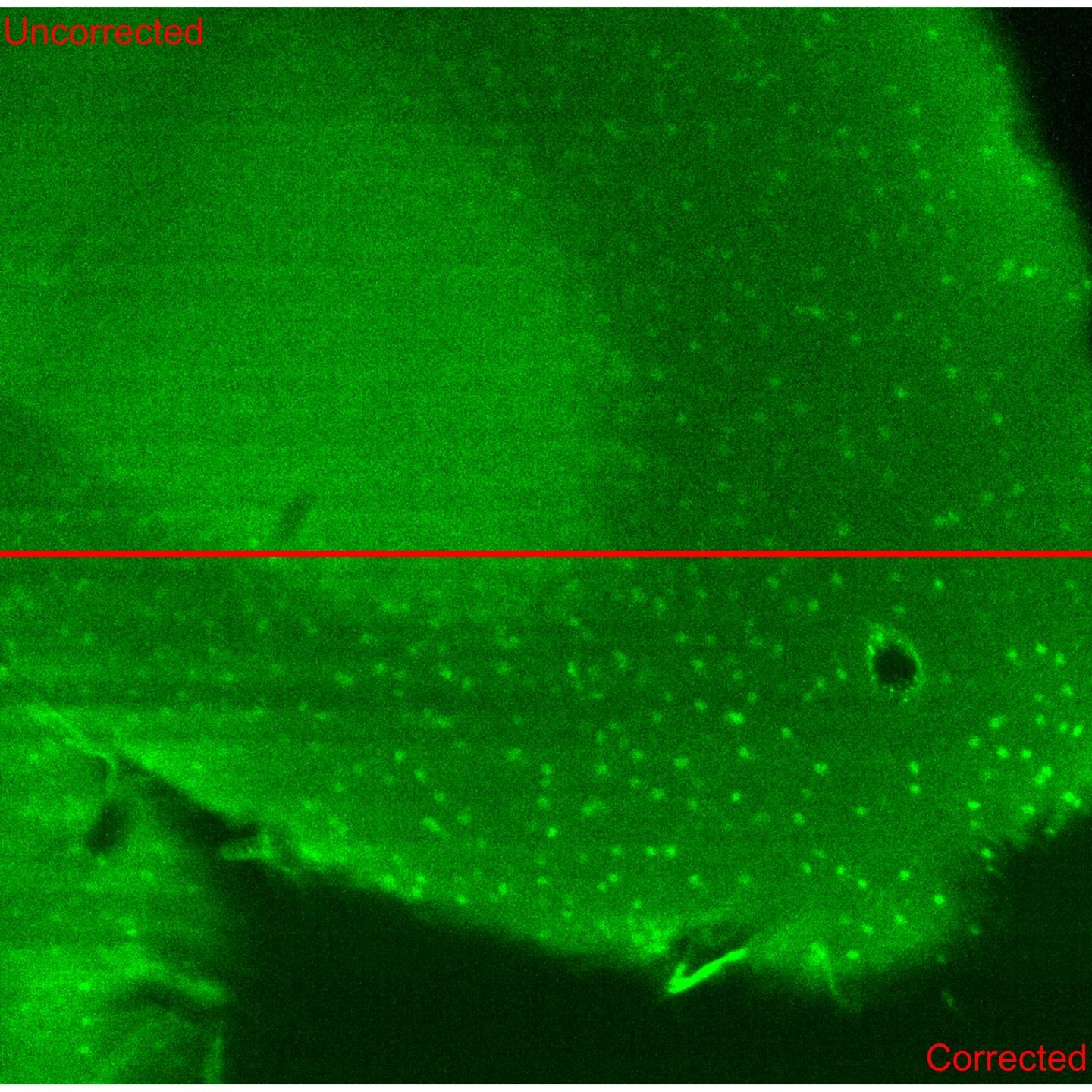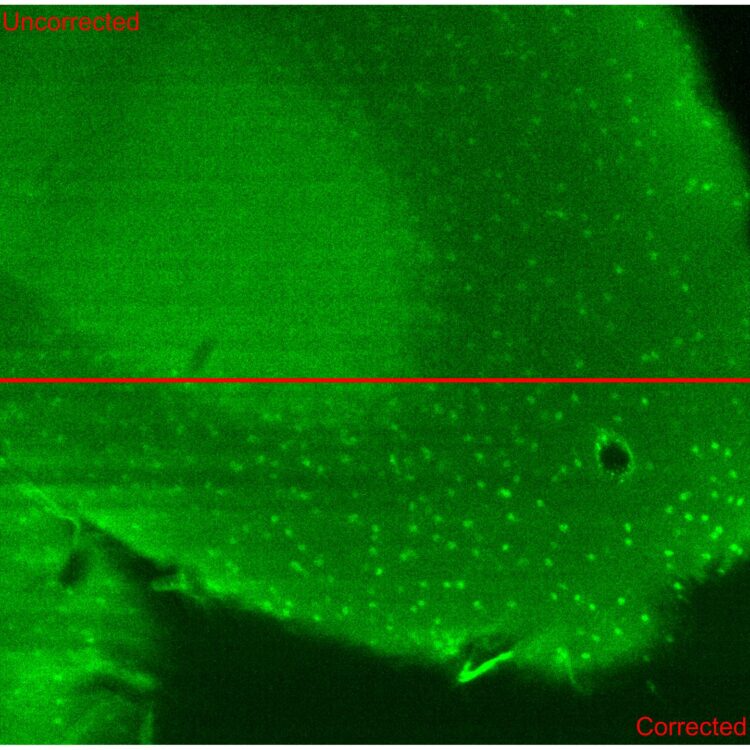
Credit: T. Furieri (CNR-IFN), G. Calisei and A. Bassi (Politecnico of Milan), E. Daini and A. Vilella (University of Modena and Reggio Emilia)
WASHINGTON — Researchers have developed a new plug-and-play device that can add adaptive optics correction to commercial optical microscopes. Adaptive optics can greatly improve the quality of images acquired deep into biological samples, but has, until now, been extremely complex to implement.
“Improving the technology available to life scientists can further our understanding of biology, which will, in turn, lead to better drugs and therapies available to doctors,” said research team leader, Paolo Pozzi from the University of Modena and Reggio Emilia in Italy.
In The Optical Society (OSA) journal Optics Letters, Pozzi and a multidisciplinary team of researchers from Delft University of Technology (TU Delft), CNR-Institute for Photonics and Nanotechnology (CNR-IFL) and University Medical Center Rotterdam describe their new adaptive lens device. They also show how it can be easily installed onto the objective lens of a commercial multiphoton microscope to improve image quality.
“This approach will allow advanced optical techniques such as multiphoton microscopy to image deeper under the surface of the brain in live organisms,” said Stefano Bonora, group leader at the CNR-IFL. “We look forward to seeing how it might also be implemented in other systems, such as light-sheet microscopes, super-resolution systems, or even simple epifluorescence microscopes.”
Imaging deeper
Optical microscopy can be used to image biological samples in natural conditions, making it possible to observe various biological processes over time. However, as light travels through tissue it gets distorted. This distortion gets worse as light travels deeper into tissue, causing images to look blurry and obscuring important details.
Adaptive optics, a technology initially developed to compensate for atmospheric turbulence when using telescopes to view celestial objects, can be used to correct the optical aberrations that occur when imaging through thick tissue. However, doing so typically requires building a custom microscope that incorporates a deformable mirror. This mirror is used to compensate for the distortions, creating an image that looks sharp and clear.
“Including a deformable mirror in an existing microscope is nearly impossible, and no commercial adaptive microscope is available on the market yet,” said Pozzi. “This means that the only option for a life scientist to use adaptive optics is to build the entire microscope from scratch, an operation which is too difficult and time consuming for most life sciences laboratories.”
A simpler approach
To simplify this setup, the researchers created a smart lens made with glass so thin it can bend without breaking. The lens consists of a glass disk-shaped container filled with a transparent liquid. A set of 18 mechanical actuators on the glass edges can be controlled with a computer to bend the glass to a desired shape.
The lens functions like the deformable mirror used in most adaptive optics setups, but instead of reflecting light, it transmits light. As light travels through the liquid inside the lens, it gets distorted differently depending on the shape of the lens. “This is similar to the distorted images you see when looking through a bottle of water while squishing it with your hands,” said Bonora.
Using the lens for adaptive optics correction requires a complex algorithm to control the actuators. “Efficient optical correction was made possible by the DONE algorithm (database online nonlinear extremum-seeker), a very elegant solution based on machine learning-like principles, which we previously developed at TU Delft,” said Pozzi.
Quick results
The researchers tested the new software, which is also made available to others via github, and adaptive lens by applying it to the objective lens of a commercial multiphoton microscope. They used the microscope to perform calcium imaging on the brains of living mice, one of the most complex life science experiments performed with microscopes.
“We surpassed our expectations by achieving very nice results within a few hours,” said Pozzi. “This technology can be retrofitted on any existing microscope that has interchangeable objectives and displays images on a computer screen.”
The researchers are now testing the system on other types of microscopes and samples while also exploring whether multiple adaptive lenses could be used to achieve a better correction than is possible with more complex techniques using deformable mirrors. The team has also founded a spin-off company, Dynamic Optics srl, to commercialize the multiactuator adaptive lenses.
The new lens could also be useful for applications beyond microscopy. “Our new device could also be applied in other fields such as free space optics communications, where it could increase data connection rates and bring data connections to remote and isolated areas,” said Pozzi.
###
Paper: P. Pozzi, M. Quintavalla, A. B. Wong, J. G. G. Borst, S. Bonora, M. Verhaegen, “Plug-and-play adaptive optics for commercial laser scanning fluorescence microscopes based on an adaptive lens,” Opt. Lett., 45, 13, 3585-3588 (2020).
DOI: https:/
About Optics Letters
Optics Letters offers rapid dissemination of new results in all areas of optical science with short, original, peer-reviewed communications. Optics Letters accepts papers that are noteworthy to a substantial part of the optics community. Published by The Optical Society and led by Editor-in-Chief Miguel Alonso, Institut Fresnel, École Centrale de Marseille and Aix-Marseille Université, France, University of Rochester, USA. Optics Letters is available online at OSA Publishing.
About The Optical Society
Founded in 1916, The Optical Society (OSA) is the leading professional organization for scientists, engineers, students and business leaders who fuel discoveries, shape real-life applications and accelerate achievements in the science of light. Through world-renowned publications, meetings and membership initiatives, OSA provides quality research, inspired interactions and dedicated resources for its extensive global network of optics and photonics experts. For more information, visit osa.org.
Media Contact:
[email protected]
Media Contact
James Merrick
[email protected]
Original Source
https:/
Related Journal Article
http://dx.





